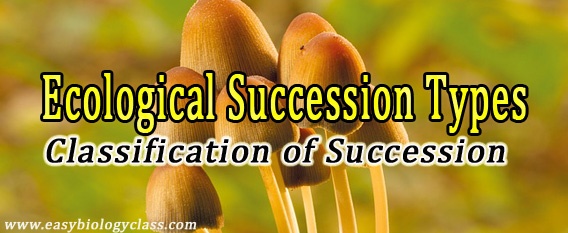In the previous post, we have discussed the Process of Ecological Succession. Here we will discuss the classification of different types of ecological successions. The ecological succession is classified into different types based on different criterions such as the origin of succession, cause, community composition and nature of substratum. An outline of the classification is given below:
(1). Primary and Secondary Succession (based on the starting of succession)
(2). Autogenic and Allogenic Succession (based on the cause of succession)
(3). Autotrophic and Heterotrophic Succession (based on the community composition)
(4). Hydrosere and Xerosere (based on the nature substratum)
(5). Microsuccession (succession of microbes)
You may also like NOTES in...
BOTANY BIOCHEMISTRY MOL. BIOLOGY
ZOOLOGY MICROBIOLOGY BIOSTATISTICS
ECOLOGY IMMUNOLOGY BIOTECHNOLOGY
GENETICS EMBRYOLOGY PHYSIOLOGY
EVOLUTION BIOPHYSICS BIOINFORMATICS
(1). Primary Succession
Ø The primary succession starts from an area where there was no previous living matter.
Ø Example: a rock surface and a newly created pond.

Ø The first community establishing the new area is called Pioneer Community.
Ø Examples of pioneer community: Lichens (on rock surface), Phyto-planktons (pond).
(2). Secondary Succession
Ø Secondary succession starts from a previously built-up substratum (already existing living matter).
Ø Sudden changes such as fire, snowfall, biotic interventions, cause the disappearance of the existing community.
Ø The area becomes devoid of any living matter due to the above mentioned sudden causes.
Ø Such an area will be rapidly invaded by new populations and they establish a new ecosystem.
Ø The secondary succession is comparatively a rapid process than the primary succession.
(3). Autogenic Succession
Ø After the succession has begun, the communities itself modify its own environment and thus causing its own replacement.
Ø Example: In a xerarch succession taking place on the rock surface, lichens (pioneer community) produces lichen acids. These lichen acids wither the rock to form the sand. The dead and decayed lichens are added to the sand and form a thin layer of soil. Once the soil is formed, the lichens are immediately replaced by the mosses. Thus the modification of environment by lichen causes its own replacement. The collapse of an aquatic ecosystem due to algal bloom is another example.
(4). Allogenic Succession
Ø The replacement of the existing community by any external conditions or forces and not by the existing organisms.
(5). Autotrophic Succession
Ø Autotrophic succession is characterized by an early and continued dominance of plant communities.
Ø Autotrophic succession usually starts from a nutrient deficient inorganic environment.
Ø As the succession progresses, the organic matter and energy flow in the ecosystem increase.
(6). Heterotrophic Succession
Ø Here the succession is characterized by an early dominance of heterotrophs such as fungi, bacteria, actinomycetes or animals.
Ø Heterotrophic succession usually starts from a nutrient rich organic environment.
Ø As the succession progresses, the organic matter and energy flow in the ecosystem decrease.
(7). Hydrosere
Ø Also called hydrarch succession.
Ø An ecological succession starting from an area where water is abundantly present (such as a pond) is called hydrosere or hydrarch succession.
Ø The pioneer community in a hydrarch succession is phytoplanktons.
Ø The climax community will be grassland or a forest.
| You may also like... | ||
|---|---|---|
| NOTES | QUESTION BANK | COMPETITIVE EXAMS. |
| PPTs | UNIVERSITY EXAMS | DIFFERENCE BETWEEN.. |
| MCQs | PLUS ONE BIOLOGY | NEWS & JOBS |
| MOCK TESTS | PLUS TWO BIOLOGY | PRACTICAL |
(8). Xerosere
Ø Also called xerarch succession.
Ø It is an ecological succession starting from an area where water content is very less such as a rock surface.
Ø The pioneer community in the xeroxere will be lichens.
Ø The climax community will be a grass land or a forest.
(9). Microsere
Ø Microsere or microsuccession is the succession of microorganisms such as bacteria and fungi in a micro habitat.
Ø Microsuccession is also called as serule.
